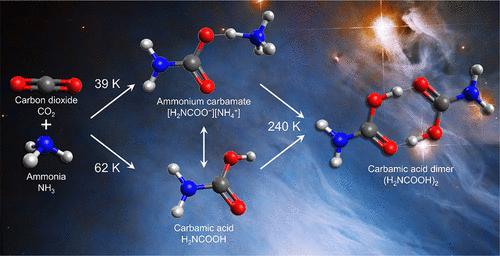当前位置:
X-MOL 学术
›
ACS Cent. Sci.
›
论文详情
Our official English website, www.x-mol.net, welcomes your feedback! (Note: you will need to create a separate account there.)
Thermal Synthesis of Carbamic Acid and Its Dimer in Interstellar Ices: A Reservoir of Interstellar Amino Acids
ACS Central Science ( IF 12.7 ) Pub Date : 2023-11-29 , DOI: 10.1021/acscentsci.3c01108 Joshua H. Marks, Jia Wang, Bing-Jian Sun, Mason McAnally, Andrew M. Turner, Agnes H.-H. Chang, Ralf I. Kaiser
ACS Central Science ( IF 12.7 ) Pub Date : 2023-11-29 , DOI: 10.1021/acscentsci.3c01108 Joshua H. Marks, Jia Wang, Bing-Jian Sun, Mason McAnally, Andrew M. Turner, Agnes H.-H. Chang, Ralf I. Kaiser

|
Reactions in interstellar ices are shown to be capable of producing key prebiotic molecules without energetic radiation that are necessary for the origins of life. When present in interstellar ices, carbamic acid (H2NCOOH) can serve as a condensed-phase source of the molecular building blocks for more complex proteinogenic amino acids. Here, Fourier transform infrared spectroscopy during heating of analogue interstellar ices composed of carbon dioxide and ammonia identifies the lower limit for thermal synthesis to be 62 ± 3 K for carbamic acid and 39 ± 4 K for its salt ammonium carbamate ([H2NCOO–][NH4+]). While solvation increases the rates of formation and decomposition of carbamic acid in ice, the absence of solvent effects after sublimation results in a significant barrier to dissociation and a stable gas-phase molecule. Photoionization reflectron time-of-flight mass spectrometry permits an unprecedented degree of sensitivity toward gaseous carbamic acid and demonstrates sublimation of carbamic acid from decomposition of ammonium carbamate and again at higher temperatures from carbamic acid dimers. Since the dimer is observed at temperatures up to 290 K, similar to the environment of a protoplanetary disk, this dimer is a promising reservoir of amino acids during the formation of stars and planets.
中文翻译:

星际冰中氨基甲酸及其二聚体的热合成:星际氨基酸库
星际冰中的反应被证明能够在没有生命起源所需的高能辐射的情况下产生关键的生命起源分子。当存在于星际冰中时,氨基甲酸 (H 2 NCOOH) 可以作为更复杂的蛋白质氨基酸的分子构建块的凝聚相来源。在这里,在加热由二氧化碳和氨组成的模拟星际冰期间,傅里叶变换红外光谱确定了氨基甲酸热合成的下限为 62 ± 3 K,氨基甲酸铵盐的热合成下限为 39 ± 4 K ([H 2 NCOO – ][NH 4 + ])。虽然溶剂化增加了冰中氨基甲酸的形成和分解速率,但升华后不存在溶剂效应会导致解离和稳定的气相分子的显着障碍。光电离反射飞行时间质谱法对气态氨基甲酸具有前所未有的灵敏度,并证明氨基甲酸从氨基甲酸铵的分解中升华,并在更高的温度下再次从氨基甲酸二聚体升华。由于这种二聚体是在高达 290 K 的温度下观察到的,类似于原行星盘的环境,因此这种二聚体是恒星和行星形成过程中很有前途的氨基酸库。
更新日期:2023-11-29
中文翻译:

星际冰中氨基甲酸及其二聚体的热合成:星际氨基酸库
星际冰中的反应被证明能够在没有生命起源所需的高能辐射的情况下产生关键的生命起源分子。当存在于星际冰中时,氨基甲酸 (H 2 NCOOH) 可以作为更复杂的蛋白质氨基酸的分子构建块的凝聚相来源。在这里,在加热由二氧化碳和氨组成的模拟星际冰期间,傅里叶变换红外光谱确定了氨基甲酸热合成的下限为 62 ± 3 K,氨基甲酸铵盐的热合成下限为 39 ± 4 K ([H 2 NCOO – ][NH 4 + ])。虽然溶剂化增加了冰中氨基甲酸的形成和分解速率,但升华后不存在溶剂效应会导致解离和稳定的气相分子的显着障碍。光电离反射飞行时间质谱法对气态氨基甲酸具有前所未有的灵敏度,并证明氨基甲酸从氨基甲酸铵的分解中升华,并在更高的温度下再次从氨基甲酸二聚体升华。由于这种二聚体是在高达 290 K 的温度下观察到的,类似于原行星盘的环境,因此这种二聚体是恒星和行星形成过程中很有前途的氨基酸库。







































 京公网安备 11010802027423号
京公网安备 11010802027423号